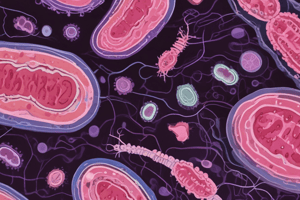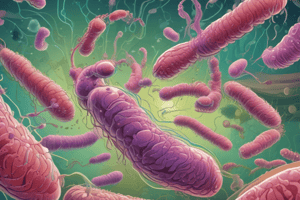Podcast
Questions and Answers
What is the main cause of traveler's diarrhea?
What is the main cause of traveler's diarrhea?
Enterotoxigenic E. coli (ETEC)
What are the major complications associated with enterohemorrhagic E. coli (EHEC)?
What are the major complications associated with enterohemorrhagic E. coli (EHEC)?
- Abdominal cramps
- Fever
- Hemolytic uremic syndrome (correct)
- Dehydration (correct)
Enterotoxigenic E. coli (ETEC) primarily affects the colon.
Enterotoxigenic E. coli (ETEC) primarily affects the colon.
False (B)
How is enteropathogenic E. coli (EPEC) primarily transmitted?
How is enteropathogenic E. coli (EPEC) primarily transmitted?
Which toxin is associated with enterohemorrhagic E. coli (EHEC)?
Which toxin is associated with enterohemorrhagic E. coli (EHEC)?
What is the primary mode of transmission for invasive E. coli (EIEC)?
What is the primary mode of transmission for invasive E. coli (EIEC)?
The initial symptoms of Enterotoxigenic E. coli (ETEC) infection include ______.
The initial symptoms of Enterotoxigenic E. coli (ETEC) infection include ______.
Which type of E. coli is linked to hemorrhagic colitis and hemolytic uremic syndrome?
Which type of E. coli is linked to hemorrhagic colitis and hemolytic uremic syndrome?
Flashcards are hidden until you start studying
Study Notes
E.coli Overview
- Different strains of E.coli exhibit distinct virulence factors that contribute to various forms of diarrhea.
- Understanding pathogenesis is crucial for recognizing symptoms and complications associated with E.coli infections.
- E.coli infections can lead to severe complications, including hemolytic uremic syndrome.
Enterotoxigenic E.coli (ETEC)
- Major cause of traveler's diarrhea; ranked second after rotavirus in hospital-based gastroenteritis cases.
- Transmission occurs primarily through fecal-oral contact, contaminated food, and occasionally through water.
- High infecting dose required (10^9 to 10^10 bacteria).
- Pathogenesis involves colonization of the proximal small intestine using fimbriae, secreting heat-labile (LT) and heat-stable (ST) toxins.
- LT affects enterocytes by increasing cyclic AMP, leading to excessive fluid secretion and diarrhea; ST activates guanylate cyclase for similar effects.
- Symptoms include rapid onset diarrhea (1-2 days), anorexia, vomiting, and abdominal cramps; lasts 1-5 days in well-nourished and can extend to 3 weeks in malnourished individuals.
- Diagnosis via stool culture and pathogenicity gene detection; treatment includes fluid replacement and antibiotics like ciprofloxacin.
Enteroinvasive E.coli (EIEC)
- Causes inflammatory diarrhea by invading colonic enterocytes; resembles Shigella in characteristics.
- Transmission mainly through fecal-oral route from infected individuals.
- Pathogenesis involves colon invasion and proliferation within the cells, causing cell death.
- Characterized by polymorphonuclear leukocyte infiltration distinct in clinical presentations.
- Symptoms present swiftly (10-18 hours IP), including fever and dysentery.
- Diagnosis via stool culture and gene detection; treated with co-trimoxazole and erythromycin.
Enteropathogenic E.coli (EPEC)
- Significant cause of diarrhea in infants, notably in developing countries.
- Transmission predominantly through contaminated infant formula or weaning food.
- Pathogenesis involves adherence to intestinal mucosa, leading to the loss of microvilli and subsequent non-inflammatory osmotic diarrhea.
- Symptoms include vomiting, fever, and glucogenic diarrhea that can lead to dehydration.
- Diagnosis through stool cultures and detection of attaching and effacing genes; treatment focuses on rehydration and nutritional support.
Enterohemorrhagic E.coli (EHEC)
- Associated with severe conditions like hemorrhagic colitis and hemolytic uremic syndrome; notably caused by serotype O157.
- Reservoirs include cattle and humans, with foodborne transmission common.
- Produces attaching and effacing lesions; secretes Vero toxins (VT-1 and VT-2) that halt protein synthesis, leading to intestinal damage.
- Clinical presentation includes abdominal cramps, diarrhea with blood, and potential systemic issues like acute renal failure.
- Diagnosis via VT detection or anti-VT antibodies; dehydration treatment is critical while antibiotics do not play a beneficial role.
Enteroaggregative E.coli (EAEC)
- Recently identified strain primarily linked to acute and persistent diarrhea.
- Displays a longer incubation period of 20-48 hours compared to other strains, emphasizing the need for awareness in symptom management.
Studying That Suits You
Use AI to generate personalized quizzes and flashcards to suit your learning preferences.




